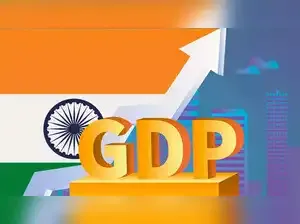The global economy is entering a new phase. After months of concern over tariffs, growth risks and volatile policymaking, the narrative has begun to shift. That was the assessment of Paul Gruenwald, global chief economist at S&P Global Ratings, during a recent visit to India.
In an interview to the Times of India, Gruenwald said that his reading of the moment was anchored in cautious optimism: pressures remain, but the macro picture is stronger than many expected earlier this year.
Gruenwald pointed out that the biggest surprise has been the changing conversation. Only in April, the dominant worry among forecasters was the drag from US tariffs. Today, attention has moved to investment in data centres and a broader capital expenditure cycle that is adding unexpected momentum.
Policy uncertainty in the US still weighs on the global outlook, but the overall environment is better than it appeared only a few months ago, Gruenwald told ToI's Sidhartha and Surojit Gupta.
A key miscalculation, he said, was the scale of tariff impact. Economists had braced for harsher measures. Initial announcements from the Trump administration indicated far higher rates than what ultimately took effect. The final US tariff rate settled at about 17%, compared with expectations that had touched 30%. This alone softened the shock.
Retaliation was also limited. Aside from China’s early tit-for-tat response, most economies chose not to escalate. Many accepted the tariffs as part of the cost of access to the American market. A 12-month extension in the understanding between President Trump and President Xi has further contained friction, at least for now.
Even the practical collection of tariffs has been lower than the statutory rate. Despite the headline figure of 17%, actual collected tariffs stand closer to an effective 10%. According to Gruenwald, the burden has so far fallen mainly on businesses—importers, wholesalers and retailers—through squeezed margins. Consumers have been partly shielded because the pass-through has been slower than forecast.
Ultimately, he expects the cost to be split roughly evenly between firms and households, but without the sweeping economic corrections some analysts had warned of. Nor has there been the revival of US-based manufacturing that politicians had promised. Instead, he characterised the episode as a tax imposed by the US on itself, absorbed within its own supply chain.
Against this backdrop, he turned to India. Along with Brazil, India remains one of the few large economies still facing unresolved tariff issues with the US. However, he suggested movement may be on the horizon and that an agreement could come soon. The bigger shift, though, is structural. Countries are reconsidering trade alignment, recalibrating dependencies and diversifying exposure as faith in the US as a reliable economic partner weakens.
India, in his view, is in a relatively favourable position during this transition. It is less dependent on the US market than many of its peers. Its status as a relatively closed economy has acted as a buffer. But this is only part of the story. The wider realignment marks a step away from the long-dominant Washington consensus, and India, like others, is reassessing global ties and managing geopolitical risk with greater intent.
Foreign investors, Gruenwald said, see India through a distinct lens. It has emerged as the fastest-growing major emerging market. The global growth baton, once firmly in China’s grip, has passed to India. What makes this shift notable is the combination of demographic strength, policy reforms and long-term investment needs—which together provide a long runway for expansion.
If India manages to maintain annual growth of about 6.5% over several years, it will achieve what he calls a “respectable” performance. The power of compounding alone would deliver outcomes that strengthen its position in the global economy. He contrasted this with China, which built much of its rapid growth on capital deepening rather than productivity gains. That strategy, he implied, led to challenges that are still unfolding. India does not need to replicate China’s pace. A steady 6–7% path would be strong in its own right.
In an interview to the Times of India, Gruenwald said that his reading of the moment was anchored in cautious optimism: pressures remain, but the macro picture is stronger than many expected earlier this year.
Gruenwald pointed out that the biggest surprise has been the changing conversation. Only in April, the dominant worry among forecasters was the drag from US tariffs. Today, attention has moved to investment in data centres and a broader capital expenditure cycle that is adding unexpected momentum.
Policy uncertainty in the US still weighs on the global outlook, but the overall environment is better than it appeared only a few months ago, Gruenwald told ToI's Sidhartha and Surojit Gupta.
A key miscalculation, he said, was the scale of tariff impact. Economists had braced for harsher measures. Initial announcements from the Trump administration indicated far higher rates than what ultimately took effect. The final US tariff rate settled at about 17%, compared with expectations that had touched 30%. This alone softened the shock.
Retaliation was also limited. Aside from China’s early tit-for-tat response, most economies chose not to escalate. Many accepted the tariffs as part of the cost of access to the American market. A 12-month extension in the understanding between President Trump and President Xi has further contained friction, at least for now.
Even the practical collection of tariffs has been lower than the statutory rate. Despite the headline figure of 17%, actual collected tariffs stand closer to an effective 10%. According to Gruenwald, the burden has so far fallen mainly on businesses—importers, wholesalers and retailers—through squeezed margins. Consumers have been partly shielded because the pass-through has been slower than forecast.
Ultimately, he expects the cost to be split roughly evenly between firms and households, but without the sweeping economic corrections some analysts had warned of. Nor has there been the revival of US-based manufacturing that politicians had promised. Instead, he characterised the episode as a tax imposed by the US on itself, absorbed within its own supply chain.
Against this backdrop, he turned to India. Along with Brazil, India remains one of the few large economies still facing unresolved tariff issues with the US. However, he suggested movement may be on the horizon and that an agreement could come soon. The bigger shift, though, is structural. Countries are reconsidering trade alignment, recalibrating dependencies and diversifying exposure as faith in the US as a reliable economic partner weakens.
India, in his view, is in a relatively favourable position during this transition. It is less dependent on the US market than many of its peers. Its status as a relatively closed economy has acted as a buffer. But this is only part of the story. The wider realignment marks a step away from the long-dominant Washington consensus, and India, like others, is reassessing global ties and managing geopolitical risk with greater intent.
Foreign investors, Gruenwald said, see India through a distinct lens. It has emerged as the fastest-growing major emerging market. The global growth baton, once firmly in China’s grip, has passed to India. What makes this shift notable is the combination of demographic strength, policy reforms and long-term investment needs—which together provide a long runway for expansion.
If India manages to maintain annual growth of about 6.5% over several years, it will achieve what he calls a “respectable” performance. The power of compounding alone would deliver outcomes that strengthen its position in the global economy. He contrasted this with China, which built much of its rapid growth on capital deepening rather than productivity gains. That strategy, he implied, led to challenges that are still unfolding. India does not need to replicate China’s pace. A steady 6–7% path would be strong in its own right.





